
Planning complete, time to go ahead and build it. I can add the finshing touches later.

Planning complete, time to go ahead and build it. I can add the finshing touches later.
John Ronald Reuel Tolkien CBE FRSL was an English writer and philologist. He was the author of the high fantasy works The Hobbit and The Lord of the Rings.

Consultants and junior doctors in England are holding their first joint strike in the history of the NHS.
The latest data from NHS England, states the number of people waiting to start routine hospital treatment is at a record high of 7.68 million at the end of July 2023. This is up from 7.57 million in June 2023 and the highest since records began in August 2007.
The waiting list has increased by more than 3 million since February 2020, the last full month before the start of the pandemic. The NHS is facing many different challenges due to the impact of Covid-19 on its services, staff and resources. This data suggests that the waiting list was already at 4 million even before the pandemic hit.
The latest strike action is a major factor now contributing to the NHS waiting list. Some reports suggest that over 850,000 routine operations and procedures have been cancelled so far this year, 2023 due to strike action alone.

What about health education?
The government has also pledged to invest an extra £36 billion over the next three years to help the NHS recover from the pandemic and reform social care. However, some experts have warned that this may not be enough to address the underlying issues that affect the NHS performance and quality, such as workforce planning, public health funding and health inequalities.
Lack of money or management failures? It has to one of these two. Throwing funds at an already badly managed ‘business’ will just amplify the problem allowing even more waste. And as the ‘system’ tackles the problem, more and more people will needlessly continue to suffer.
Fix our health service by fixing the people first!
Lao Tzu (also spelled Laozi or Lao-Tze) was a semi-legendary ancient Chinese philosopher who is credited with writing the Tao Te Ching, a classic of Chinese philosophical-religious literature.

According to legend, Lao Tzu met Confucius, the founder of Confucianism, and impressed him with his wisdom. He also tried to teach people the way of the Tao, but found them unwilling to listen. He then decided to leave civilization and retire into seclusion. Before he departed, he wrote down his teachings in the Tao Te Ching at the request of a border guard. Some Taoist sects believe that he then became an immortal.
Lao Tzu’s influence on Chinese culture is immense. He is regarded as the ancestor of the Tang dynasty (618-907 CE), one of the most prosperous and powerful periods in Chinese history. He is also revered as a deity in religious Taoism and Chinese folk religion, under the name Laojun, one of the ‘Three Pure Ones’.
His teachings have inspired many other philosophers, poets, artists, and leaders throughout history and across the world.

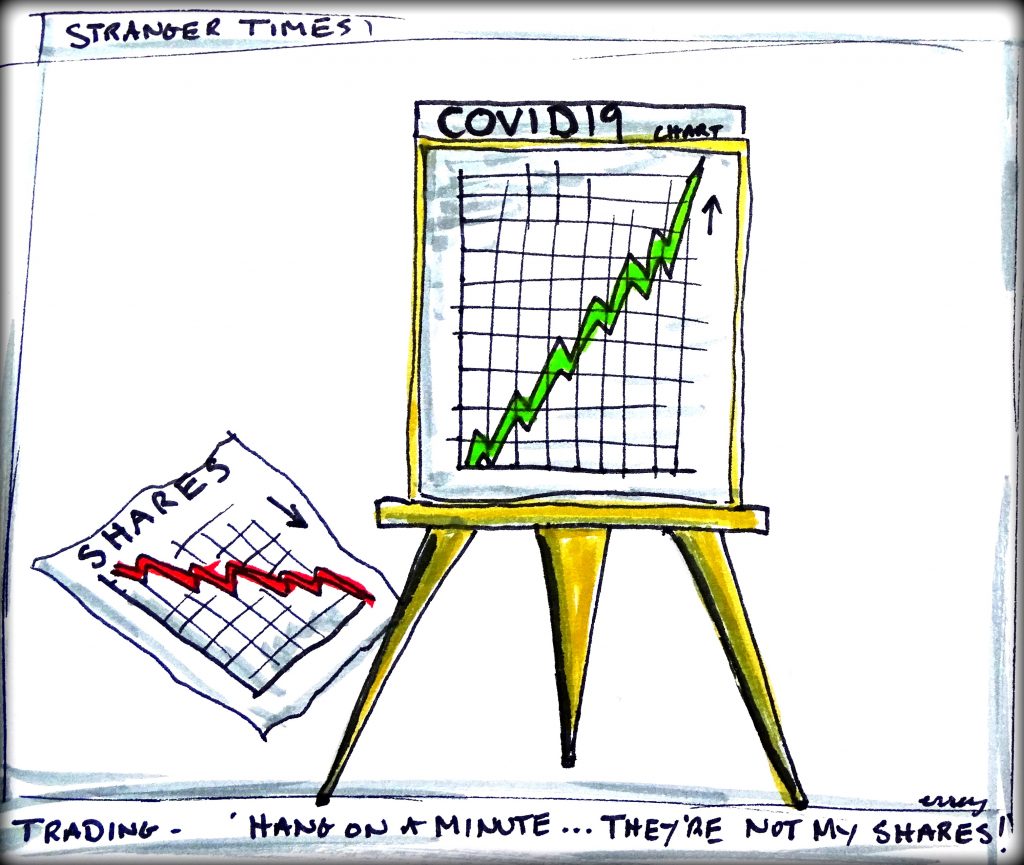
As the pandemic hit world economies, share prices plunged. But as the ‘fear’ lifted so too did the share prices.
Sequoia Capital and Andreessen Horowitz, two of Silicon Valley’s most high-profile venture firms, are poised to take a massive hit on their investments in grocery delivery company Instacart, a deal that closed in 2021 as tech stocks were soaring.
In its latest IPO prospectus update, Instacart said it plans to sell shares at $28 – $30 a share, valuing the company at around $10 billion at the top of the range. That’s more than 75% below where Sequoia and Andreessen invested in early 2021. At that time, Instacart sold shares at $125 a pop valuing Instacart at $39 billion.
The reason for the valuation collapse is that the U.S. economy reopened after the pandemic, then inflation spiked and the Federal Reserve started raising interest rates, which were stuck near to zero throughout the Covid pandemic.
Borrowed money suddenly became expensive again, and quickly too. Tech’ companies in early stages of development, need access to research and development finance – interest rate increases restricted investment.
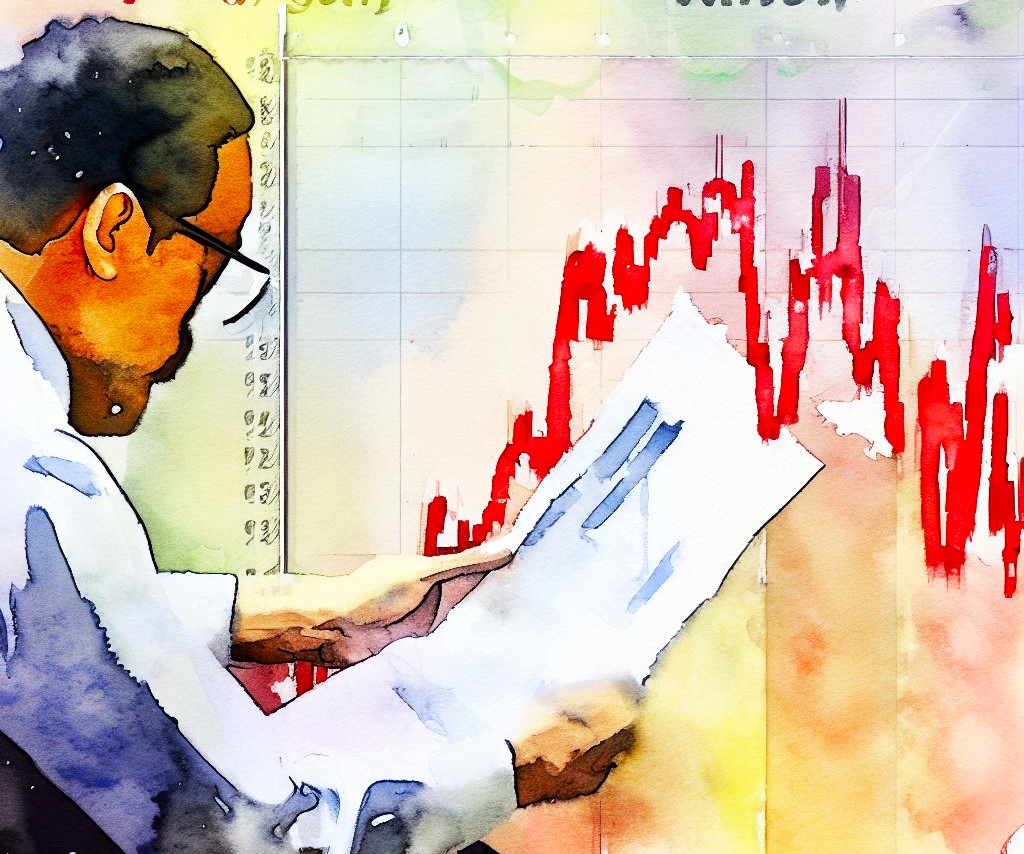
Then consumers started shopping again on foot, and with capital costs increasing, investors began demanding that companies find a strong path to profitability.
Instacart is trying to crack open an IPO market that’s been closed for venture-backed companies for nearly two years, so it won’t be easy. However, the ARM IPO recently may re-adjust that view.
George Orwell 1903 – 1950
George Orwell 1903 – 1950. This quote is ‘attributed’ to George Orwell, a British writer and journalist who is best known for his novels 1984 and Animal Farm. But this quote is most likely NOT an Orwell one – eventhough it is widely accepted as his.
It is most likely that Orwell never wrote or spoke these words, even though they have a broadly Orwellian dystopian feel to them. It would appear that this quote was first written by a conservative writer in 2009, but has been almost universally misattributed to Orwell in the intervening 12 years.
The earliest record found found and apparently the original, was descovered in a column by the conservative writer Selwyn Duke, written in 2009.
Selwyn Duke is a conservative writer and commentator who has published articles on various topics such as politics, culture, religion, and science.
Duke is known for his traditionalist and sometimes controversial views on issues such as immigration, feminism, transgenderism, and vote fraud. He has written for several online and print outlets, such as The Hill, The American Conservative, WorldNetDaily, and American Thinker.
He also has a personal website where he posts his opinions and media appearances, and is active on X.
Selwyn Duke should not to be confused with George Orwell, a British author who wrote novels such as 1984 and Animal Farm. A quote that is often misattributed to Orwell actually originated from a 2009 opinion piece by Duke

According to the latest Inflation ‘Attitudes Survey‘ conducted by the Bank of England in August 2023, confidence in Bank of England has plummeted to an all-time low.
The survey found that only 19% of the respondents were satisfied with the way the Bank of England was doing its job to set interest rates to control inflation, while 40% were dissatisfied. The net satisfaction rate was -21%, which is the lowest since the survey began in 1999.
The main reason for the low confidence is the high inflation rate that has been persisting in the UK for more than a year. Inflation reached a peak of 11.1% in December 2022, and was still at 6.8% in July 2023, well above the Bank of England’s target of 2%. The Bank of England has raised interest rates 14 times since the end of 2021, from 0.1% to 5.25%, to try to bring inflation down, but this has also increased the cost of borrowing and living for many households and businesses.
Some critics have argued that the Bank of England (BoE) acted too slowly and too cautiously to raise interest rates when inflation was rising, while others have warned that raising rates too high and too fast could harm the economic recovery from the Covid-19 pandemic.
The public’s expectations of future inflation are also high, with a median answer of 2.9% for inflation in five years’ time, almost one percentage point higher than the Bank’s target.
Confidence in Bank of England (BoE) is important because it affects how people behave in terms of spending, saving, investing, and borrowing.
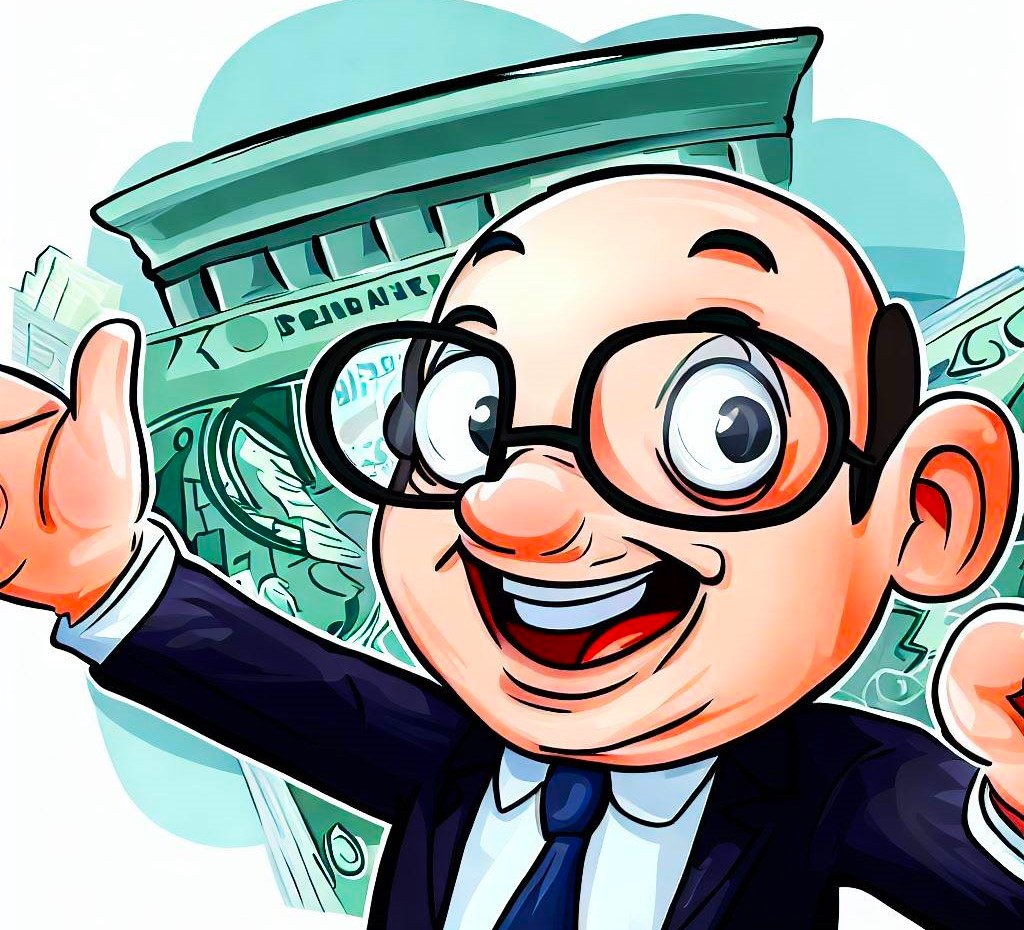
If people lose faith in the central bank’s ability to control inflation and maintain economic stability, they may act in ways that could worsen the situation, such as hoarding money, demanding higher wages, or taking on more debt.
Therefore, it is crucial for the Bank of England to communicate clearly and effectively with the public about its policies and actions, and to restore trust and confidence in its role as an independent and credible institution.
It is also useful to take notice of early warning signs, such as the economic red alert posed by inflation after the pandemic recovery started.
The FTSE 100 is the index of the 100 largest companies listed on the London Stock Exchange by market capitalization. It is one of the most widely used indicators of the UK economy and the performance of British businesses.
The FTSE 100 had its best week of the year in the week ending 15th September. The index closed at 7,711 points on 15th September 2023. This was the highest weekly gain of 2023.
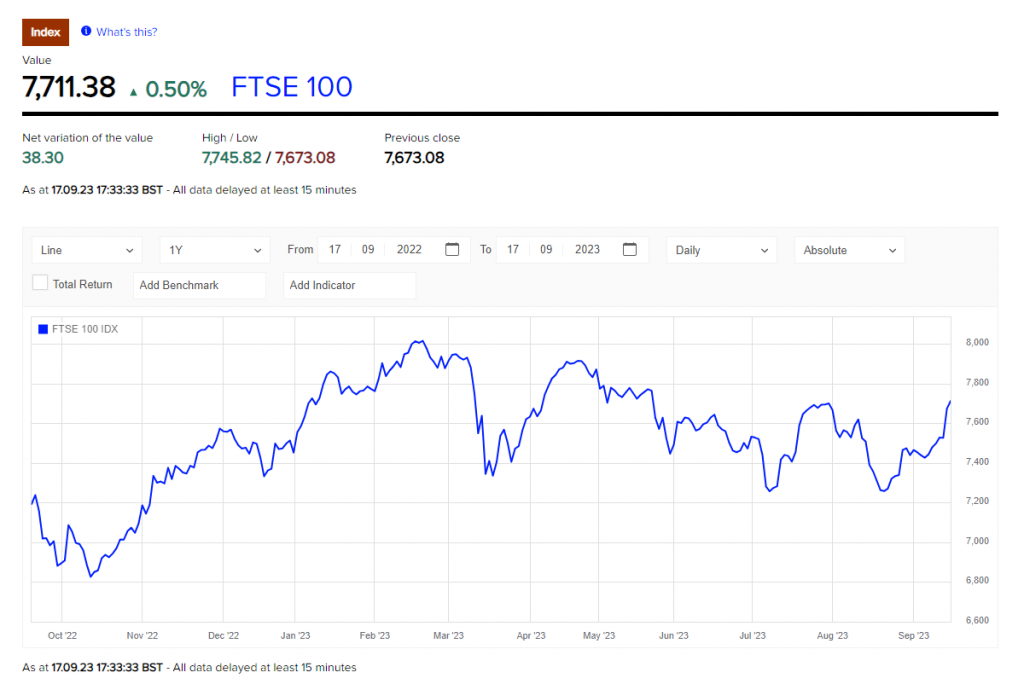
This was a strong end to the week, as the global stocks rally continued with a stable showing from Wall Street and an improvement in China.
Arm IPO led the way with a successful return tothe stock market.
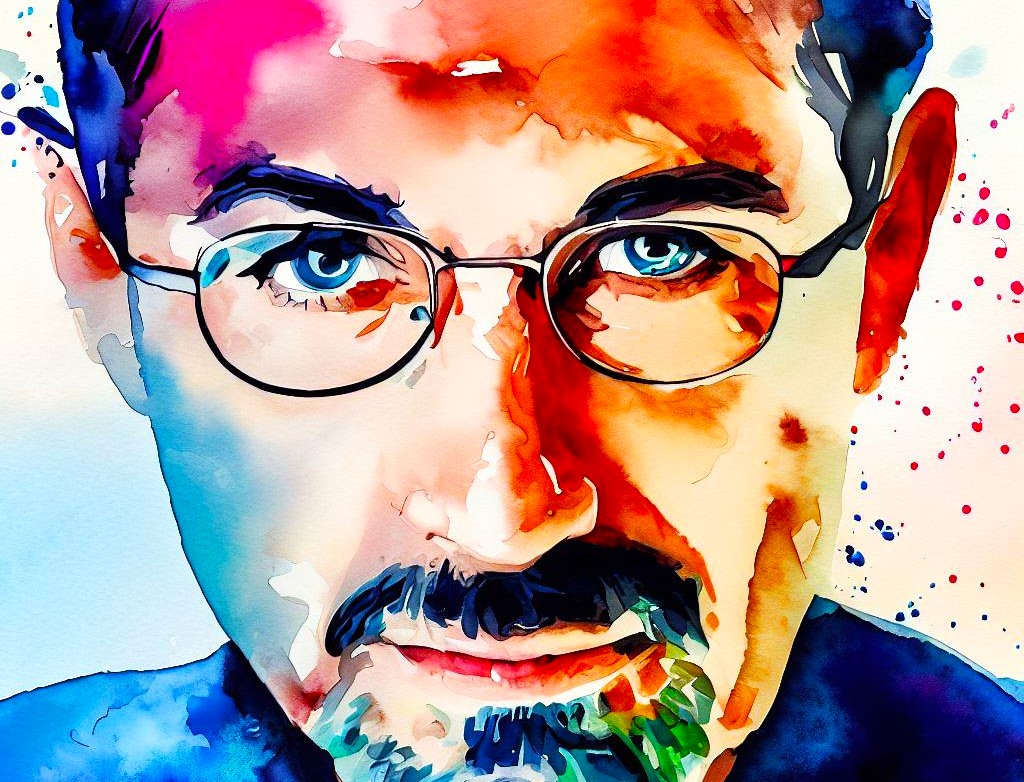
Gatwick confirmed some cancellations, while the website FlightRadar24 said hundreds of flights in and out of the airport were delayed.
The National Air Traffic Services (Nats) apologised for its staffing shortages.
Gatwick Airport said it expected a normal service on Friday, 15th September 2023.
The disruption comes just over two weeks after a technical issue at Nats that led to 2,000 flights being cancelled across the UK.
EasyJet expressed frustration at Thursday’s delays and cancellations, while Ryanair boss Michael O’Leary called on Nats’ boss to resign.
Mr O’Leary reportedly said: ‘It is unacceptable that more flights and hundreds of passengers are suffering delays to/from Gatwick Airport due to Nats CEO, Martin Rolfe’s blatant failure to adequately staff UK ATC’.
‘Airlines are paying millions of pounds to Nats each and every year and should not have to see their passengers suffer avoidable delays due to UK ATC staff shortages’.
Gatwick Airport said it was ‘operating as normal’ on Friday after a shortage of air traffic controllers caused disruption to flights overnight on Thursday, 14th September 2023.

The 66-year-old founded SoftBank, which still controls about 90% of Arm Holdings after the IPO, back in 1981 after graduating from the University of California, Berkeley. Forbes estimates his net worth at more than $24 billion, making him the world’s 69th richest person.
Son made his early reputation as an investor in Japan’s mobile phone industry, and went on to become one of the first backers of Yahoo as well as Alibaba. Son continues to serve as the chairman of Arm’s board of directors.
AI does pose some threats to humanity if mishandled, Son said, likening its potential misuse to the dangers of speeding, or drinking alcohol while driving a car. But, more positively, AI can also help solve key world problems like diseases or help mitigate or recover from natural disasters, he reportedly said.
‘AI, society should regulate to protect humankind’, Son said. ‘However, it has more merit than the demerits. So, I think I’m a believer. I’m optimistic that AI is going to solve the issues that mankind couldn’t solve in the past‘.
The bank raised its key rate for the 10th time in a row, to 4% from 3.75%, as it warned inflation was expected to remain too high for too long.
The latest increase came after forecasts predicted inflation, which is the rate prices rise at, would be 5.6% on average in 2023. However, the ECB signalled that this latest hike could be the last for now.
‘The council considers that the key ECB interest rates have reached levels that, maintained for a sufficiently long duration, will make a substantial contribution to the timely return of inflation to the target’, the bank reportedly said. The central bank originally expected inflation to be ‘transitory’.
It added that it expected inflation in the 20-nation bloc to fall to around 2.9% next year and 2.2% in 2025.
As in other parts of the world, the eurozone has been hit by rising food and energy prices that have squeezed household budgets and from the Russia/Ukraine war. Central banks have been increasing interest rates in an attempt to tame inflation and slow rising prices.
The theory behind increasing rates is that by making it more expensive for people to borrow money, the ‘consumer’ will then have less excess cash to spend, meaning households will buy fewer things and then price rises will ease. But it is a balancing act as raising rates too aggressively could cause a recession.
Interest rates in the UK are currently higher than in the eurozone at 5.25%, but UK inflation is also higher at 6.8%, and the Bank of England is expected to raise rates again next week.
NASA has recently released a report on Unidentified Anomalous Phenomena (UAP), which is another term for UFOs. The report is based on a yearlong study of hundreds of UAP sightings by scientists and data experts.
NASA found no evidence that aliens are behind the UAPs, but it also could not rule out the possibility. The report said that some of the objects must have travelled through our solar system to get here.
NASA said that the study of UAPs will require new scientific techniques, including advanced satellites and artificial intelligence. The agency also announced a new director of UAP research to establish a robust database and analysis process.
NASA said that UAPs are important for national security and air safety, as some of them pose potential threats to aircraft and military operations. The agency also said that it will share data and findings with more transparency and collaboration.
NASA said that many UAP sightings can be explained by natural phenomena, human-made objects, or sensor errors, but some remain unexplained and anomalous. The report estimated that only about 2% to 5% of the total database are thought to be truly anomalous.
The shares ended the day worth more than $63 each, after climbing by almost 25% from the high end start of $51 per share set by Arm.
The sale was the biggest initial public offering of the year, raising $4.87 billion for owner Softbank Group.
Despite some concerns surrounding the company’s exposure to risks in China and a potential AI slowdown – the shares soared.
A star of the British technology industry, Arm designs microchips for devices including smartphones and game consoles. It estimates that some 70% of the world’s population uses products that rely on its chips, including nearly all of the world’s smartphones. And with AI nestling in on the horizon, the future potential for Arm is massive.

Arm said it expects the total market for its chip designs to be worth about $250 billion by 2025, including new growth areas such as data centres and cars.
Many of Arm’s royalties come from products released decades ago. About half of the company’s royalty revenue of $1.68 billion in 2022, came from products released between 1990 and 2012.
The future looks bright for Arm but the company is trading at more than 25 times its most recent full year of revenue, and at more than 100 times profit.
And that could be where things get tricky for Arm in the not too distant future. Projections for future profits will be interesting, esecially if it’s to keep up with Nvidia for instance.

Blackberries are a very healthy food, packed with antioxidants that can help prevent cancer and other diseases.
Blackberries can be picked from late summer through to mid-autumn. The earlier ones tend to be better raw, the later good for cooking.
A ripe blackberry is deep black with a plump, full feel. It should come away easily when pulled from the stem.
Blackberries can stain your hands and clothes.
Blackberry tea was used to cure dysentery.

There are two types of blackberries: thorny and thornless. Thorny blackberries have more flavour, but thornless ones are easier to pick.
Blackberries are also known as brambles in Britain.
Bramble is the plant that produces the blackberry.
Blackberries are related to raspberries, strawberries, and roses. They belong to the rose family, Rosaceae.

Outstanding mortgage debt is now £16.9bn, the highest since 2016, it said.
Mortgage costs have risen for millions as the Bank has repeatedly hiked interest rates to slow soaring prices.
Some experts warn defaults will rise, but others say the number unable to repay remains relatively low.
According to the BoE, in April-June 16% of mortgages in arrears were new cases, which it said ‘was little changed compared to the previous quarter’.
It added that the proportion of mortgages in arrears was the highest since 2018.

According to news reports, France has banned the Apple iPhone 12 because it emits too much electromagnetic radiation, which could be harmful to human health.
The French watchdog (ANFR) said that the iPhone 12’s specific absorption rate (SAR), which measures the rate of radio frequency energy absorbed by the body, was above the legal limit of 4.0 watts per kilogram in tests simulating the phone being held in the hand or kept in a pocket.
Apple disputed the tests and said that the iPhone 12 was certified by multiple international bodies and compliant with all global radiation standards. The French digital minister said that Apple had two weeks to respond and fix the issue, or else he would order a recall of all iPhone 12 devices sold in the country.
The minister also said that France would share its findings with other regulators in the European Union, which could lead to a wider ban of the phone.
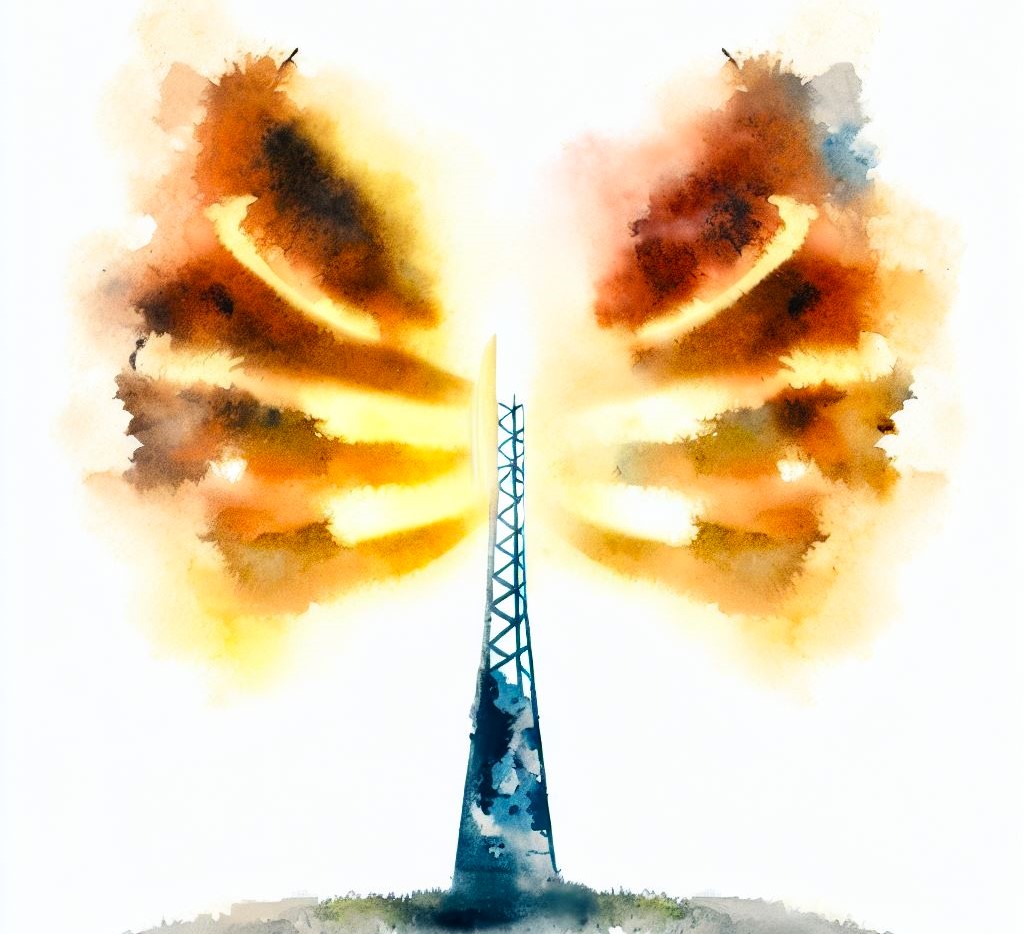
Radiation from mobile phones is a type of electromagnetic radiation that is emitted by cell phones and cordless phones when they send and receive signals. Electromagnetic radiation is a form of energy that travels in waves or particles through space.
It can be classified into two types: ionizing and non-ionizing radiation. Ionizing radiation has high energy and can damage DNA, which may increase the risk of cancer such as; x-rays, radon, and cosmic rays. Non-ionizing radiation has low energy and cannot damage DNA directly – such as; radio waves, microwaves, infrared, visible light, and ultraviolet light.
Cell phones use radiofrequency (RF) waves, which are a type of non-ionizing radiation, to communicate with cell towers and other devices. RF waves have frequencies ranging from 0.7 to 80 GHz, depending on the generation of the cell phone (2G, 3G, 4G, or 5G). The human body can absorb some of the RF energy from cell phones, which may cause some heating to the area of the body where the phone is held (e.g., the ear and head). However, it is suggested this heating is not enough to raise the core body temperature or cause any harmful effects.
There has been a lot of research on whether cell phone use can cause health problems, such as cancer, in humans. However, it has been reported that the evidence so far is not conclusive and does not show a clear link between cell phone use and cancer risk. There could be a link but we do not know 100%… yet?
Some studies have suggested that there may be a small increase in the risk of certain types of brain tumors (such as acoustic neuromas) for people who use cell phones for a long time or frequently. However, other studies have not found any consistent evidence to support this.
The incidence of brain and central nervous system cancers has not changed significantly during the time that cell phone use has increased dramatically. Therefore, more research is needed to understand the possible effects of cell phone use on human health.
The latest inflation figures for the U.S. show that the annual inflation rate rose to 3.7% in August 2021, up from 3.2% in July 2021. This was mainly driven by a sharp increase in energy prices, which jumped up 10.5% over the last month. Gas (petrol) prices accounted for more than half of the increase in the overall inflation rate.
However, core inflation, which excludes the volatile food and energy sectors, slowed down to 4.3% in August 2021, down from 4.7% in July 2021. This suggests that the Federal Reserve’s ’11’ rate hikes are having some effect on cooling the inflationary pressures in the economy. Some sectors, such as used cars, medical care services and airfare, saw price decreases in August 2021.

Will the Fed keep interest rates unchanged at its next meeting on September 20, 2021, as we wait to see the full impact of its previous rate hikes on the economy?
However, the Fed may still raise interest rates later this year if inflation remains persistently above its target of 2%. Higher interest rates could introduce more volatility to the U.S. economy and potentially trigger a recession.
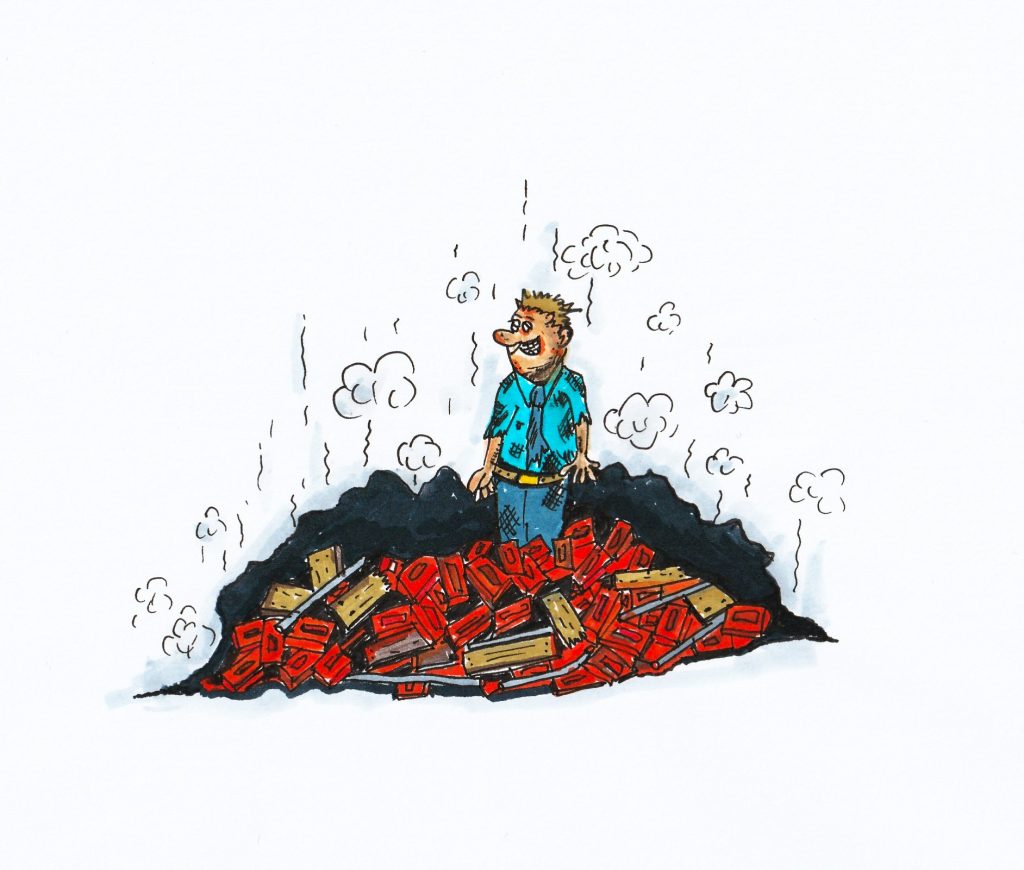
Wet weather also hit the construction and retail industries, the Office for National Statistics (ONS) said, causing the economy to contract by 0.5%.
The figures were worse than analysts had predicted and continue a trend of weak economic growth in the UK.
Office for National Statistics (ONS) for UK GDP as at 13th September 2023..
Production output fell by 0.7% in July 2023, after growth of 1.8% in June 2023.
The construction sector fell by 0.5% in July 2023, after growth of 1.6% in June 2023.
Not a recession, but the weather gets the blame for slowing up UK progress!
The upcoming IPO of Arm Holdings, the British chip designer that is owned by SoftBank Group is already oversubscribed by more than 10 times. Bankers plan to stop taking orders by the afternoon of 12th Deptember 2023.
This means that there is a massive demand for the shares and the company may raise more money than expected. The IPO could end up as much as 15 times oversubscribed by Wednesday 13th September 2023, which would indicate a very high valuation for Arm.
Arm filed for its IPO at $47 to $51 a share, which could value the company at $54.5 billion at the high end of the range. However, Arm is still reportedly considering raising the price range of its IPO. This could easily make Arm one of the most valuable tech companies in the world.
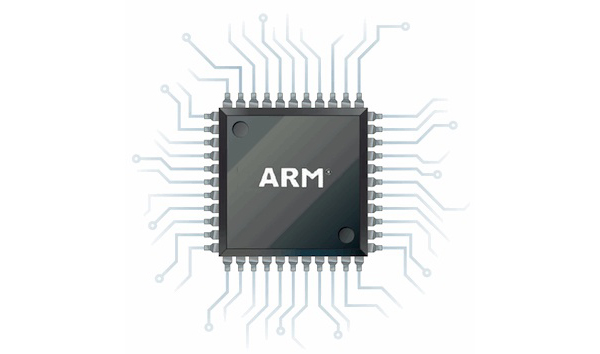
Arm is a key part of the chip supply chain, designing semiconductors found in most of the world’s smartphones, as well as other devices and applications.
Arm is poised to become a bigger and more profitable business, as it shifts to high-margin chips and benefits from the boom in cloud computing and artificial intelligence (AI).
Arm’s CEO Rene Haas has been pitching investors on this pivot and the growth prospects of the company.
What a success story.
The Magnificent Seven is a term to describe seven tech’ stocks that have been surging in 2023.
These seven stocks are considered to be dominant in their respective fields and have strong growth prospects driven by innovation and artificial intelligence (AI).
They have outperformed the broader market and attracted many investors who are looking for exposure to the tech’ sector. Some analysts believe that these stocks will continue to lead the market in the future, while others caution that they may face regulatory challenges, competition, or valuation issues.
The approximate combined market cap value of the Magnificent Seven as of September 2023 is approximately $11.8 trillion.
Note that these values will change over time as the stock prices fluctuate.
There are many funds that can trade tech stocks, depending on your investment objectives, risk tolerance, and preferences.
Technology mutual funds: These are funds that invest in a diversified portfolio of technology companies across different industries, such as software, hardware, internet, cloud, biotech, and more. Technology mutual funds can offer exposure to the growth potential of the tech sector, as well as reduce the volatility and risk of investing in individual stocks.
Some examples of technology mutual funds are Fidelity Select Technology Portfolio (FSELX), Columbia Global Technology Growth Fund (CGTYX), and Schwab U.S. Large-Cap Growth Index Fund (SCHG).

Technology exchange-traded funds (ETFs): These are funds that track an index of technology stocks and trade on an exchange like a stock. Technology ETFs can offer low-cost and convenient access to the tech sector, as well as allow investors to choose from different themes, such as cybersecurity, artificial intelligence (AI), cloud computing and more.
Some examples of technology ETFs are Invesco QQQ Trust (QQQ), Technology Select Sector SPDR Fund (XLK), and VanEck Vectors Semiconductor ETF (SMH).
Technology index funds: These are funds that replicate the performance of a specific technology index, such as the Nasdaq 100, the S&P 500 Information Technology Index, or the Morningstar U.S. Technology Index. Technology index funds can offer broad and passive exposure to the tech sector, as well as low fees and high tax efficiency.
Some examples of technology index funds are Fidelity NASDAQ Composite Index Fund (FNCMX), Vanguard Information Technology Index Fund Admiral Shares (VITAX), and iShares Morningstar U.S. Technology ETF (IYW).
NOTE: These are not recommendations. Investments may go up or down. Your money is at risk!
Always do your own research…
REASEARCH! REASEARCH! RESEARCH!
Martin Luther was a German theologian and leader of the Protestant Reformation in the 16th century. He is known for his writings and teachings on topics such as justification by faith, the authority of Scripture, the priesthood of all believers, and the freedom of the Christian.
He also translated the Bible into German and wrote many hymns, catechisms, and commentaries.
He is widely regarded as one of the most influential figures in the history of Christianity.

Apple sells around 50 million iPhones in China annually. A sweeping ban is what investors fear and that spells trouble for Apple.
Apple stock drops after The Wall Street Journal reported a day earlier that Chinese authorities have curbed the use of the iPhone. Apple’s flagship product will no longer be legal to use by some central government officials.
The potential crackdown threatens to dissrupt Apple’s sales as China accounts for about 20% of Apple’s total revenue. Uncertainties about the news prompted investors to retreat from Apple postions, leading to a 6% drop in Apple shares in two days. More than $200bn of market cap was wiped out.

Adding to the concern, Apple is just days away from its key event. On the 12th september 2023, the company is expected to officially announce the launch of its newest smartphone – the iPhone 15.